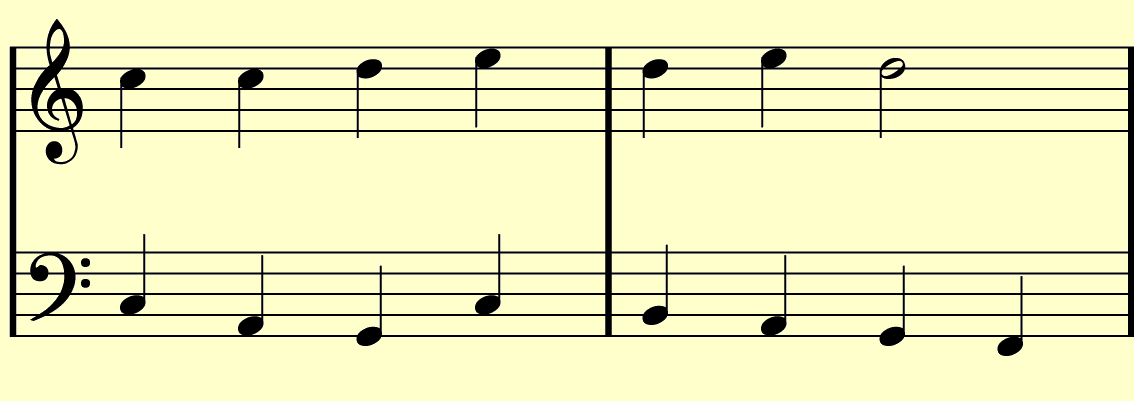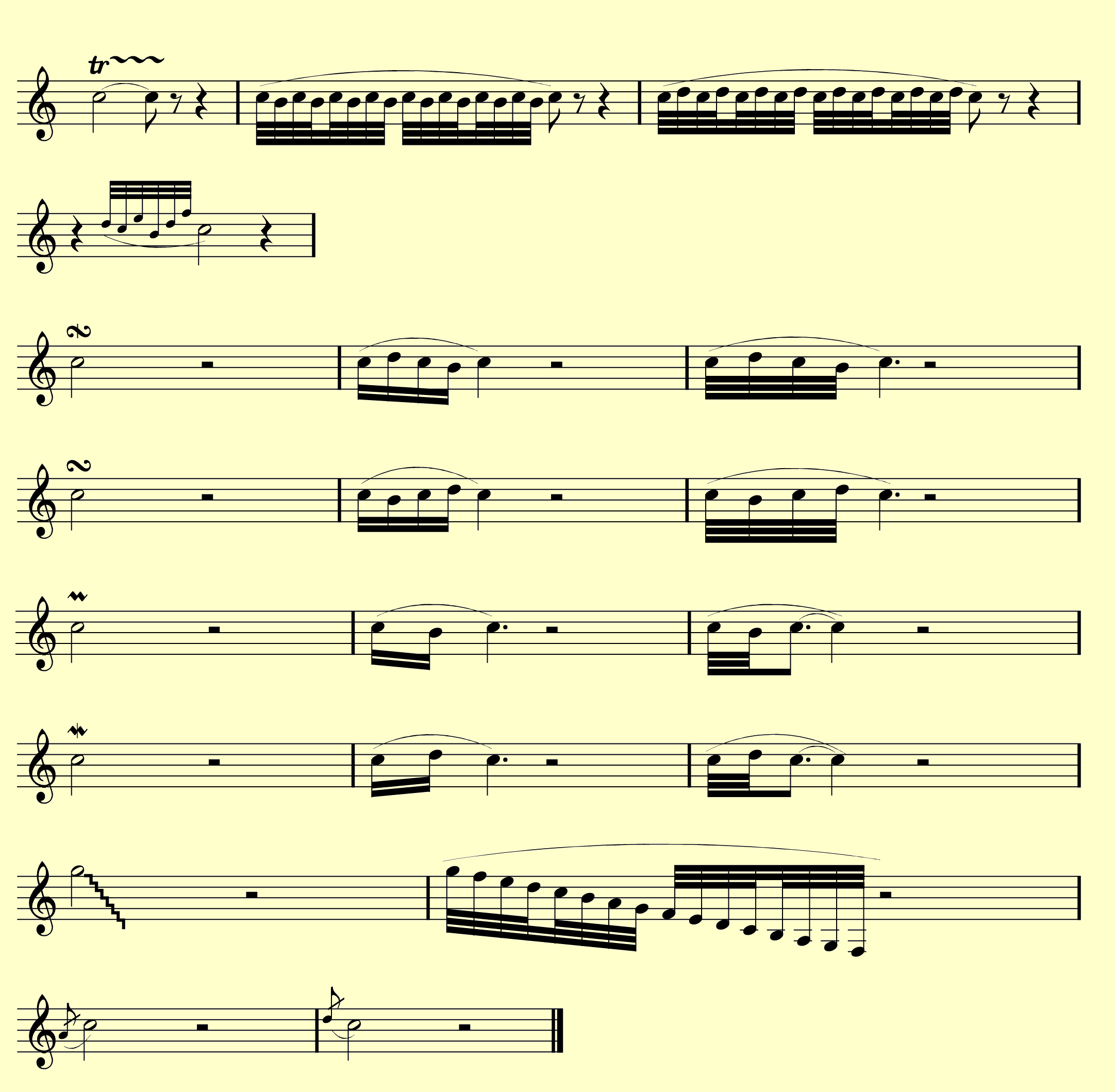You are using an out of date browser. It may not display this or other websites correctly.
You should upgrade or use an alternative browser.
You should upgrade or use an alternative browser.
How do you embellish a melody , help please ¿
- Thread starter 10ndaYii
- Start date
bandcoach
Zukatoku - Mod Scientist
For any note:
This is the basic approach to embellishment. It is known as adding mordents or neighbour tones (upper or lower or upper and lower or lower and upper)
- play the note
- play the scale tone note above
- play the note
- play the note
- play the scale tone note below
- play the note
- play the note
- play the scale tone note above
- play the note
- play the scale tone note below
- play the note
- play the note
- play the scale tone note below
- play the note
- play the scale tone note above
- play the note
This is the basic approach to embellishment. It is known as adding mordents or neighbour tones (upper or lower or upper and lower or lower and upper)
bandcoach
Zukatoku - Mod Scientist
It implies using non-chord tones. passing notes are what we call non-chord tones between two chord tones a 3rd apart.
Some examples to make this more concrete.
Upper neighbour tones
Followed by lower neighbour tones
Followed by upper-lower and lower-upper neighbour tones
[mp3]http://www.bandcoach.org/fp/audio/neighbourTones-01.mp3[/mp3]

A simple melody
[mp3]http://www.bandcoach.org/fp/audio/neighbourTones-02.mp3[/mp3]

Embellishment 1
[mp3]http://www.bandcoach.org/fp/audio/neighbourTones-03.mp3[/mp3]

Embellishment 2
[mp3]http://www.bandcoach.org/fp/audio/neighbourTones-04.mp3[/mp3]

Embellishment 3
[mp3]http://www.bandcoach.org/fp/audio/neighbourTones-05.mp3[/mp3]

Some examples to make this more concrete.
Upper neighbour tones
Followed by lower neighbour tones
Followed by upper-lower and lower-upper neighbour tones
[mp3]http://www.bandcoach.org/fp/audio/neighbourTones-01.mp3[/mp3]

A simple melody
[mp3]http://www.bandcoach.org/fp/audio/neighbourTones-02.mp3[/mp3]

Embellishment 1
[mp3]http://www.bandcoach.org/fp/audio/neighbourTones-03.mp3[/mp3]

Embellishment 2
[mp3]http://www.bandcoach.org/fp/audio/neighbourTones-04.mp3[/mp3]

Embellishment 3
[mp3]http://www.bandcoach.org/fp/audio/neighbourTones-05.mp3[/mp3]

Last edited:
To embellish a melody, you need to know what is an embellishment.
An embellishment is a type of decoration that uses NCT (non chord tones), tones that usually occur on a weak beat that are not in adherence to the chord played.
Types of NCT's:
The passing tone.
The Neighbor tone.
The suspension.
The retardation.
The anticipation.
The escape tone.
The appoggriatura.
Types of embellishments:
Trill
Grupetto
Mordent
Glissando
Acciaccatura
Use these to "embellish" your piece.
Btw, if you're talking about expanding your piece from a theme or phrase. That's a different story.
An embellishment is a type of decoration that uses NCT (non chord tones), tones that usually occur on a weak beat that are not in adherence to the chord played.
Types of NCT's:
The passing tone.
The Neighbor tone.
The suspension.
The retardation.
The anticipation.
The escape tone.
The appoggriatura.
Types of embellishments:
Trill
Grupetto
Mordent
Glissando
Acciaccatura
Use these to "embellish" your piece.
Btw, if you're talking about expanding your piece from a theme or phrase. That's a different story.
bandcoach
Zukatoku - Mod Scientist
What you have described above can at best be called a list of ornaments without explanation.
I agree that all of these are embellishments to some extent. And yes in most cases they are non-chord tones, but not always.
However, with the exception of the trill and accacciatura, they may not necessarily be an embellishment of a melody as such. They are more of a melodic device, stemming from their use in the development of species counterpoint.
I agree that all of these are embellishments to some extent. And yes in most cases they are non-chord tones, but not always.
However, with the exception of the trill and accacciatura, they may not necessarily be an embellishment of a melody as such. They are more of a melodic device, stemming from their use in the development of species counterpoint.
- Passing tones are used in joining chord tones in a melody
- Neighbour tones are explained in the post above.
- Suspension is the holding of a chord tone over to the next chord where it is a non-chord tone
- The retardation is a delaying of melodic and harmonic closure.
- The anticipation is the holding of a non-chord tone over a chord into a chord where it is a chord tone.
- The escape tone or cambiata is a device used to avoid parallel 5ths and 8ves. The melodic line moves 2nd 3rd (reverse direction) 2nd 2nd
- The appoggiatura or accented passing tone is the non-chord tone played on a strong beat.
- Trill - use of upper or lower neighbour tones in a repeated quick alternation.
- Grupetto is a group of grace notes according to several sources, although wikipedia lists it as the turn which is the alternation between upper and lower neighbour tones as described above - Melodic Tone - Upper NT - Melodic Tone - Lower NT. In Baroque ornamentation, the turn starts on the upper NT and moves to the lower NT and then back to the main melodic tone. An inverted turn would start on the lower NT and move to the upper NT and then back the main tone.
- Mordent is an older name for use of upper or lower neighbour tones
- Glissando is a short or long movement from one note to another including all intervening notes: on violin and other un-fretted strings it also includes microtones. On fretted strings and woodwinds and brasswinds it includes all chromatic notes. On the keyboard it is usually a white key only gesture or a black key only gesture.
- Acciaccatura is the italian name for a single grace note. They may be similar to appogiaturra in that they are non chord tones, or they can be upper or lower chord tones. In either case the purpose is to play the note quicly before the main written note, either robbing some of the duration of the main note or robbing from the preceding notes duration depending on style, genre and historical period.
Majestic Mastermind
Eat, Sleep, Breathe MUSIC
Syncopation
Mixing different structural tones at the end and within each phrase
Mixing different structural tones at the end and within each phrase
Someone did the dirty work. LOL.
This guy defined the terms I gave, sir.
What you have described above can at best be called a list of ornaments without explanation.
I agree that all of these are embellishments to some extent. And yes in most cases they are non-chord tones, but not always.
However, with the exception of the trill and accacciatura, they may not necessarily be an embellishment of a melody as such. They are more of a melodic device, stemming from their use in the development of species counterpoint.
- Passing tones are used in joining chord tones in a melody
- Neighbour tones are explained in the post above.
- Suspension is the holding of a chord tone over to the next chord where it is a non-chord tone
- The retardation is a delaying of melodic and harmonic closure.
- The anticipation is the holding of a non-chord tone over a chord into a chord where it is a chord tone.
- The escape tone or cambiata is a device used to avoid parallel 5ths and 8ves. The melodic line moves 2nd 3rd (reverse direction) 2nd 2nd
- The appoggiatura or accented passing tone is the non-chord tone played on a strong beat.
- Trill - use of upper or lower neighbour tones in a repeated quick alternation.
- Grupetto is a group of grace notes according to several sources, although wikipedia lists it as the turn which is the alternation between upper and lower neighbour tones as described above - Melodic Tone - Upper NT - Melodic Tone - Lower NT. In Baroque ornamentation, the turn starts on the upper NT and moves to the lower NT and then back to the main melodic tone. An inverted turn would start on the lower NT and move to the upper NT and then back the main tone.
- Mordent is an older name for use of upper or lower neighbour tones
- Glissando is a short or long movement from one note to another including all intervening notes: on violin and other un-fretted strings it also includes microtones. On fretted strings and woodwinds and brasswinds it includes all chromatic notes. On the keyboard it is usually a white key only gesture or a black key only gesture.
- Acciaccatura is the italian name for a single grace note. They may be similar to appogiaturra in that they are non chord tones, or they can be upper or lower chord tones. In either case the purpose is to play the note quicly before the main written note, either robbing some of the duration of the main note or robbing from the preceding notes duration depending on style, genre and historical period.
This guy defined the terms I gave, sir.
bandcoach
Zukatoku - Mod Scientist
Can some one elaborate the stuff below
Types of embellishments:
Trill
Grupetto
Mordent
Glissando
Acciaccatura ¿
I don't understand those types .
[MP3]http://www.bandcoach.org/fp/audio/ornaments.mp3[/MP3]
In sequence
- Trill - Lower then upper
- Gruppetto - True, then Turn then Inverted turn
- Mordent - lower then upper
- Glissando - downward only illustrated
- Acciaccatura - lower and upper

